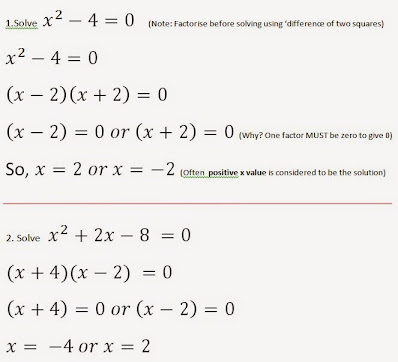*The Quadratic Formula can be used to
solve any Quadratic equation. But, students must know how to use it; they must
know values of a, b, & c; know their directed numbers; and know how to
simplify surds.
Showing posts with label factorising. Show all posts
Showing posts with label factorising. Show all posts
Factorising and Solving Quadratic Equations - GCSE Basic Algebra Questions
Students often find certain topics like Algebra challenging. I’d like to identify the
difference between simple and complex quadratic equations and solve them as
examples. The questions are real GCSE (UK/Edexcel) exam questions.
To solve a quadratic equation (equation of the
highest power of 2), one MUST first know how to factorise the equation.
Factorising and solving simple quadratic expressions
Factorising and solving simple quadratic expressions (and
equations) like x2 – 4 (difference of 2 squares) and x2
+ 4x + 4 can be easy.
But such this work, introduced in Grade 9 or
10, often paves way for harder questions in later years.
See the illustrations below on how to solve quadratic equations. You can relate these examples to the questions your teachers set for you.
Solving Simple Quadratic Equations

Factoring Method or Quadratic Formula (Part I)
The factoring method is introduced early in Year 7 and covered extensively in the later years at secondary schools.
More on Solving Complex Quadratic Equations
Find out either to Factorise and solve or use the Quadratic formula in Part (II)
Download GCSE Maths past papers
You can download the past GCSE exam papers online. Here are some websites that many students prefer to use.
- Maths Genie
- Maths Watch
- Dr Frost maths
- Cobette Maths
- GCSE maths in four weeks
Stationery items you will need for exams are available at Ryman: GCSE maths stationery items
Algebra II - Higher Order Questions Sorted by Topic
If this PDF file does not open, click on 'Open in new window' arrow. (Here ▼)
Introduction to Algebra
If this PDF file does not open, click on 'Open in new window' arrow. (Here ▼)



